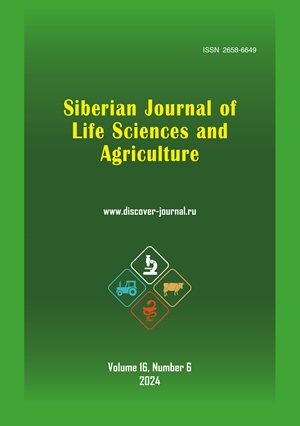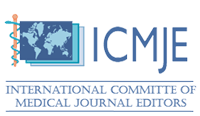ОПТИМИЗАЦИЯ ЛИОФИЛИЗАЦИИ БАКТЕРИЙ: ВЛИЯНИЕ ПАРАМЕТРОВ КУЛЬТИВИРОВАНИЯ И ЛИОФИЛИЗАЦИИ НА ВЫЖИВАЕМОСТЬ ПРОБИОТИКОВ
Аннотация
Обоснование. Сохранение бактериальных культур имеет важное значение в научных исследованиях и промышленном производстве, как пищевого, так и медицинского назначения. Исследование влияния процесса лиофилизации на выживаемость бактерий имеет важное значение для разработки эффективных методов применения пробиотиков. На основании анализа более трехсот публикаций отечественных и зарубежных исследовательских групп, выделено около тридцати ключевых факторов, оказывающих влияние на сохранность бактерий в процессе лиофилизации. Однако для уравнения, описывающего выживаемость бактерий при лиофилизации, были учтены семнадцать параметров, которые являются наиболее значимыми для обеспечения успешной лиофилизации бактериальных культур. Стоит отметить, что при детальном рассмотрении, многие факторы в общем уравнении выживаемости невозможно или очень сложно отследить. В связи с этим, в представленной работе были приняты допущения для упрощения уравнения. Выявление функции ценности, отражающей насколько ценно влияние введенного параметра на выживаемость микроорганизмов после криозаморозки позволит создать виртуальную модель процесса для исследования выживаемости бактерий.
Цель. Целью данного обзора является выявление и обобщение параметров, влияющих на выживаемость бактерий в процессе лиофилизации, а также поиск закономерностей между основными параметрами физических процессов и выживаемостью бактерий после лиофилизации и криоконсервации.
Материалы и методы. Поиск литературы был осуществлен с использованием следующих электронных баз данных: GoogleScholar, ScienceDirect, PudMed, КиберЛенинка. Поисковые запросы включали комбинации следующих фраз: «лиофилизация бактерий», «исследование пробиотиков», «криоконсервация», «уравнение выживаемости бактерий при лиофилизации», «функция ценности».
Результаты. Бактериальные культуры являются важным компонентом многих научных и медицинских исследований. Сохранение чистых культур важно для того, чтобы обеспечить их жизнеспособность и полезность для будущих исследований. Существует несколько методов сохранения бактериальных культур: охлаждение, замораживание и лиофилизацию. В работе основной фокус уделяется факторам, влияющим на накопление бактериальной массы при культивировании, а также факторам, влияющим на выживаемость бактерий при лиофилизации. На основе отобранных параметров найдено уравнение, включающее наиболее значимые параметры, влияющие на выживаемость бактерии при криоконсервации и лиофилизации. Однако при детальном рассмотрении уравнения были выявлены параметры, которые в большинстве исследований являются постоянными при работе с молочнокислыми бактериями. В работе представлен обзор параметров и режимов культивирования и лиофилизации, влияющих на выживаемость бактерий. Различные факторы, такие как подготовительные этапы, параметры культивирования и замораживание, оказывают влияние на функцию выживаемости бактерий при лиофилизации. Понимание этих факторов имеет ключевое значение для оптимизации процесса лиофилизации и повышения эффективности сохранения микроорганизмов. Дальнейшие исследования в этой области помогут улучшить качество консервированных пробиотиков и расширить область их применения.
Заключение. В рамках работы было проанализировано более трехсот публикаций отечественных и зарубежных исследовательских групп, из которых было отобран 31 наиболее важный фактор, влияющий на выживаемость бактерий при лиофилизации. Однако, много параметров в общем уравнении выживаемости значительно усложняют расчет, а порой влияют опосредованно. В связи с этим, в представленной работе были проведены исследования для упрощения уравнения. Таким образом, данный обзор позволит в дальнейшем получить функцию ценности для оптимизации процесса и повышения эффективности сохранения микроорганизмов при криоконсервации и лиофилизации. Такой подход позволит сделать модель более удобной для анализа и применения на практике.
Информация о спонсорстве. Работа выполнена при поддержке РНФ № 23-16-00224
EDN: YNAEBU
Скачивания
Литература
Грачева И.В., Осин А.В. Механизмы повреждений бактерий при лиофилизации и протективное действие защитных сред // Проблемы особо опасных инфекций. 2016. № 3. С. 5–12. (Gracheva I.V., Osin A.V. Mechanisms of bacterial damage during lyophilization and protective effect of protective media. Problems of especially dangerous infections, 2016, no. 3, pp. 5-12). https://doi.org/10.21055/0370-1069-2016-3-5-12
Merivaara A. et al. Preservation of biomaterials and cells by freeze-drying: Change of paradigm. Journal of Controlled Release, 2021, vol. 336, pp. 480–498. https://doi.org/10.1016/j.jconrel.2021.06.042
Murray K.A., Gibson M.I. Chemical approaches to cryopreservation. Nat Rev Chem., 2022, vol. 6, no. 8, pp. 579–593. https://doi.org/10.1038/s41570-022-00407-4
Wolkers W.F., Oldenhof H. Principles Underlying Cryopreservation and Freeze-Drying of Cells and Tissues. 2021, pp. 3–25. https://doi.org/10.1007/978-1-0716-0783-1_1
Bellali S. et al. A new protectant medium preserving bacterial viability after freeze drying. Microbiol Res., 2020, vol. 236, 126454. https://doi.org/10.1016/j.micres.2020.126454
Peiren J., Hellemans A., De Vos P. Impact of the freeze-drying process on product appearance, residual moisture content, viability, and batch uniformity of freeze-dried bacterial cultures safeguarded at culture collections. Appl Microbiol Biotechnol, 2016, vol. 100, no. 14, pp. 6239–6249. https://doi.org/10.1007/s00253-016-7359-1
Hauptmann A., Hoelzl G., Loerting T. Optical cryomicroscopy and differential scanning calorimetry of buffer solutions containing cryoprotectants. European Journal of Pharmaceutics and Biopharmaceutics, 2021, vol. 163, pp. 127–140. https://doi.org/10.1016/j.ejpb.2021.03.015
Broeckx G. et al. Drying techniques of probiotic bacteria as an important step towards the development of novel pharmabiotics. Int J Pharm., 2016, vol. 505, no. 1–2, pp. 303–318. https://doi.org/10.1016/j.ijpharm.2016.04.002
Santivarangkna C., Higl B., Foerst P. Protection mechanisms of sugars during different stages of preparation process of dried lactic acid starter cultures. Food Microbiol., 2008, vol. 25, no. 3, pp. 429–441. https://doi.org/10.1016/j.fm.2007.12.004
Briggs M. et al. The Preservation of Lactobacilli by Freeze-drying. J Gen Microbiol., 1955, vol. 12, no. 3, pp. 503–512. https://doi.org/10.1099/00221287-12-3-503
Meng F.-B. et al. Effect of Lactobacillus plantarum and Lactobacillus acidophilus fermentation on antioxidant activity and metabolomic profiles of loquat juice. LWT, 2022, vol. 171, 114104. https://doi.org/10.1016/j.lwt.2022.114104
Anh Ngoc Le T., Jie Lin Lee J., Ning Chen W. Stimulation of lactic acid production and Lactobacillus plantarum growth in the coculture with Bacillus subtilis using jackfruit seed starch. J Funct Foods, 2023, vol. 104, 105535. https://doi.org/10.1016/j.jff.2023.105535
Wang T. et al. Food-grade expression system of Lactobacillus plantarum using β-galactosidase small subunit as selection marker and lactose as screening condition. LWT, 2023, vol. 182, 114922. https://doi.org/10.1016/j.lwt.2023.114922
Tian J., Yin G., Zhang J. Combined metabolomic and proteomic analyses reveal the aerobic and respirative life-style of Lactobacillus plantarum SXC48. LWT, 2023, vol. 185, 115216. https://doi.org/10.1016/j.lwt.2023.115216
Zong C. et al. Klebsiella as an α-tocopherol source facilitating Lactobacillus plantarum fermentation in rice straw silage1. J Integr Agric., 2024, vol. 23, no. 12, pp. 4186-4202. https://doi.org/10.1016/j.jia.2023.11.036
Anh Ngoc Le T., Jie Lin Lee J., Ning Chen W. Stimulation of lactic acid production and Lactobacillus plantarum growth in the coculture with Bacillus subtilis using jackfruit seed starch. J Funct Foods, 2023, vol. 104, 105535. https://doi.org/10.1016/j.jff.2023.105535
Renschler M.A. et al. Using nitrous acid-modified de Man, Rogosa, and Sharpe medium to selectively isolate and culture lactic acid bacteria from dairy foods. J Dairy Sci., 2020, vol. 103, no. 2, pp. 1215–1222. https://doi.org/10.3168/jds.2019-17041
Thomas R.M. et al. Nutritional and sensory quality of Ofada rice sourdough bread made with selected lactic acid bacteria strains. Heliyon, 2023, vol. 9, no. 10, e20828. https://doi.org/10.1016/j.heliyon.2023.e20828
Spacova I. et al. Development of a live biotherapeutic throat spray with lactobacilli targeting respiratory viral infections. Microbial Biotechnology, 2023, vol. 16, no. 1, pp. 99–115. https://doi.org/10.1111/1751-7915.14189
Li D. et al. Quercetin-enriched Lactobacillus aviarius alleviates hyperuricemia by hydrolase-mediated degradation of purine nucleosides. Pharmacol Res., 2023, vol. 196, 106928. https://doi.org/10.1016/j.phrs.2023.106928
Phengnoi P. et al. Characterization of levansucrase produced by novel Bacillus siamensis and optimization of culture condition for levan biosynthesis. Heliyon., 2022, vol. 8, no. 12, e12137. https://doi.org/10.1016/j.heliyon.2022.e12137
Duong T. et al. Characterization of the tre Locus and Analysis of Trehalose Cryoprotection in Lactobacillus acidophilus NCFM. Appl Environ Microbiol., 2006, vol. 72, no. 2, pp. 1218–1225. https://doi.org/10.1128/AEM.72.2.1218-1225.2006
Teng D. et al. Stabilization of freeze-dried Lactobacillus paracasei subsp. paracasei JCM 8130T with the addition of disaccharides, polymers, and their mixtures. Bioscience, Biotechnology, and Biochemistry, 2017, vol. 81, no. 4, pp. 768–773. https://doi.org/10.1080/09168451.2017.1279852
Coghetto C.C. et al. Lactobacillus plantarum BL011 cultivation in industrial isolated soybean protein acid residue. Brazilian Journal of Microbiology, 2016, vol. 47, no. 4, pp. 941–948. https://doi.org/10.1016/j.bjm.2016.06.003
Fossi B.T. et al. Probiotic lactic acid bacteria isolated from traditional cameroonian palm wine and corn beer exhibiting cholesterol lowering activity. Heliyon., 2022, vol. 8, no. 11, e11708. https://doi.org/10.1016/j.heliyon.2022.e11708
Lacerda Massa N.M. et al. Effects of digested jabuticaba (Myrciariajaboticaba (Vell.) Berg) by-product on growth and metabolism of Lactobacillus and Bifidobacterium indicate prebiotic properties. LWT, 2020, vol. 131, 109766. https://doi.org/10.1016/j.lwt.2020.109766
Papadopoulou E. et al. Adaptive laboratory evolution to hypersaline conditions of lactic acid bacteria isolated from seaweed. N Biotechnol., 2023, vol. 75, pp. 21–30. https://doi.org/10.1016/j.nbt.2023.03.001
Jiang Y. et al. The therapeutic effects of fermented milk with lactic acid bacteria from traditional Daqu on hypertensive mice. J Dairy Sci., 2024, vol. 107, no. 2, pp. 742–758. https://doi.org/10.3168/jds.2023-23858
Illikoud N. et al. Development of innovative fermented products by exploiting the diversity of immunomodulatory properties and fermentative activity of lactic and propionic acid bacteria. Food Research International, 2023, vol. 166, 112557. https://doi.org/10.1016/j.foodres.2023.112557
Tatsaporn T., Kornkanok K. Using Potential Lactic Acid Bacteria Biofilms and their Compounds to Control Biofilms of Foodborne Pathogens. Biotechnology Reports, 2020, vol. 26, e00477. https://doi.org/10.1016/j.btre.2020.e00477
Rocha-Mendoza D. et al. Growth of lactic acid bacteria in milk phospholipids enhances their adhesion to Caco-2 cells. J Dairy Sci., 2020, vol. 103, no. 9, pp. 7707–7718. https://doi.org/10.3168/jds.2020-18271
Ahmed W.I. et al. Biocontrol of Bacillus cereus by Lactobacillus plantarum in Kareish cheese and yogurt. LWT, 2023, vol. 183, 114946. https://doi.org/10.1016/j.lwt.2023.114946
Wang G.-Q. et al. Influence of freezing temperature before freeze-drying on the viability of various Lactobacillus plantarum strains. J Dairy Sci., 2020, vol. 103, no. 4, pp. 3066–3075. https://doi.org/10.3168/jds.2019-17685
Stefanello R.F. et al. Survival and stability of Lactobacillus fermentum and Wickerhamomycesanomalus strains upon lyophilisation with different cryoprotectant agents. Food Research International, 2019, vol. 115, pp. 90–94. https://doi.org/10.1016/j.foodres.2018.07.044
Bodzen A. et al. Design of a new lyoprotectant increasing freeze-dried Lactobacillus strain survival to long-term storage. BMC Biotechnol., 2021, vol. 21, no. 1, p. 66. https://doi.org/10.1016/j.foodres.2018.07.044
Giulio B. De et al. Use of alginate and cryo-protective sugars to improve the viability of lactic acid bacteria after freezing and freeze-drying. World J Microbiol Biotechnol., 2005, vol. 21, no. 5, pp. 739–746. https://doi.org/10.1007/s11274-004-4735-2
Просмотров аннотации: 28 Загрузок PDF: 12
Copyright (c) 2024 Mariia S. Ashikhmina, Vladislav S. Filozop, Mikhail O. Volodarskiy, Sviatlana A. Ulasevich, Ekaterina V. Skorb

Это произведение доступно по лицензии Creative Commons «Attribution-NonCommercial-NoDerivatives» («Атрибуция — Некоммерческое использование — Без производных произведений») 4.0 Всемирная.





















































